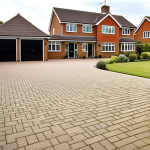Revolutionary HVAC Innovations: Energy-Saving Solutions for Large Building Efficiency
As the world grapples with the challenges of climate change and rising energy costs, the HVAC (Heating, Ventilation, and Air Conditioning) industry is undergoing a significant transformation. New technologies and innovative solutions are emerging to make large buildings more energy-efficient, sustainable, and comfortable. Here’s a deep dive into the revolutionary HVAC innovations that are changing the game.
Embracing Sustainability: The New Norm in HVAC Systems
Sustainability has become a cornerstone of modern HVAC systems. The push towards decarbonization and reduced environmental impact is driving the development of energy-efficient solutions. One of the key trends is the adoption of heat pumps, which are significantly more energy-efficient and environmentally friendly compared to traditional heating methods.
Additional reading : Essential Considerations for Investing in Real Estate Close to Transit Hubs: Maximizing Your Property”s Potential
Heat Pumps: The Future of Heating and Cooling
Heat pumps, especially smart heat pumps, are at the forefront of this sustainability drive. These systems use advanced technology to optimize energy efficiency, comfort, and convenience. Unlike traditional heat pumps, smart heat pumps integrate with IoT (Internet of Things) and AI algorithms to predict and adjust to your heating and cooling needs. For instance, smart heat pumps can boast an efficiency rating of up to 300%, meaning they produce three times the energy they consume, significantly reducing energy usage and utility costs.
Advanced HVAC Technologies for Energy Efficiency
Several advanced technologies are being integrated into HVAC systems to enhance energy efficiency and sustainability.
In parallel : Exploring the Impact of the UK Building Safety Act on Future Development Projects
Smart Automation and Controls
Building Automation Systems (BAS) are revolutionizing the way HVAC systems operate. These systems enable real-time monitoring and adjustment of temperature settings, occupancy-based control of different zones, predictive maintenance alerts, and remote system management. For example, smart controls can reduce energy waste by nearly 15% compared to traditional manual controls by dynamically responding to changing conditions and occupancy patterns.
Variable Speed Drives and Compressors
Modern HVAC systems are equipped with variable speed drives and compressors that adjust their output based on real-time demand. This approach ensures that the system operates at the optimal level, reducing energy waste and providing better temperature control. Variable speed compressors, in particular, can pressurize refrigerant to enable the heat transfer process efficiently, making them ideal for large buildings.
Innovative HVAC Solutions for Large Buildings
Several innovative solutions are specifically designed to address the unique challenges of large buildings.
VRF Systems, Rooftop Units, and Chiller Systems
-
VRF Systems: These are excellent for mid-sized offices, hotels, and retail spaces. They offer zone control, quiet operation, and minimal ductwork, making them highly efficient and flexible.
-
Initial Cost: High
-
Energy Efficiency: Excellent
-
Maintenance: Moderate
-
Key Benefits: Zone control, quiet operation, minimal ductwork
-
Rooftop Units: Ideal for retail centers and warehouses, these units are known for their simple installation, space-saving design, and easy access.
-
Initial Cost: Moderate
-
Energy Efficiency: Good
-
Maintenance: Easy
-
Key Benefits: Simple installation, space-saving, easy access
-
Chiller Systems: Suitable for large offices, hospitals, and malls, these systems offer superior cooling capabilities but come with a very high initial cost and complex maintenance.
-
Initial Cost: Very High
-
Energy Efficiency: Very Good
-
Maintenance: Complex
-
Key Benefits: Superior cooling, ideal for 50,000+ sq ft
| System Type | Best For | Initial Cost | Energy Efficiency | Maintenance | Key Benefits |
|---|---|---|---|---|---|
| VRF Systems | Mid-sized offices, hotels, retail | High | Excellent | Moderate | Zone control, quiet operation, minimal ductwork |
| Rooftop Units | Retail centers, warehouses | Moderate | Good | Easy | Simple installation, space-saving, easy access |
| Chiller Systems | Large offices, hospitals, malls | Very High | Very Good | Complex | Superior cooling, ideal for 50,000+ sq ft |
| Multi-Split Systems | Small offices, restaurants | Moderate | Good | Moderate | Flexible installation, independent control |
Heat Recovery and Smart Scheduling
Heat recovery systems capture and reuse waste heat, significantly reducing energy consumption. Smart scheduling aligns system operation with building usage, ensuring that the HVAC system is not wasting energy when the building is unoccupied. These features, combined with advanced filtration systems and demand-controlled ventilation, optimize energy use while maintaining high air quality.
Startups Leading the HVAC Innovation Charge
Several startups are at the forefront of HVAC innovation, bringing groundbreaking technologies to the market.
Quilt and Blue Frontier
-
Quilt: This startup combines advanced heat pump technology with AI to create a more responsive and energy-efficient system. Their AI algorithms learn from user preferences and patterns, automatically adjusting temperatures for maximum comfort and energy savings. Quilt’s focus on both form and function makes their system appealing to design-conscious homeowners.
-
Blue Frontier: Blue Frontier’s smart air conditioning system changes the concentration of a salt solution to create cooling with minimal energy requirements. This system decouples humidity control from air temperature control, ensuring optimal comfort levels. It requires less than half the electricity of conventional systems and does not consume electricity when in operation.
Hydronic Shell and Phononic
-
Hydronic Shell: This startup has developed a new category of HVAC and facade system that enables deep energy retrofits of existing multifamily buildings. Their system dramatically reduces greenhouse gas emissions and heating and cooling energy consumption by an order of magnitude, while improving thermal comfort and indoor air quality.
-
Phononic: Phononic is rethinking traditional cooling and heating technologies with their solid-state solutions. Their innovative approaches are creating new markets and transforming industries by offering more efficient and sustainable heating and cooling solutions.
Practical Insights and Actionable Advice
For building owners and facility managers looking to adopt these innovative HVAC solutions, here are some practical insights and actionable advice:
Assess Your Current System
Before investing in new technologies, assess your current HVAC system to identify areas of inefficiency. This could involve energy audits and performance analytics to understand where energy is being wasted.
Choose the Right Technology
Select the most appropriate HVAC technology based on your building’s specific needs. For example, VRF systems might be ideal for mid-sized offices, while chiller systems are better suited for large spaces.
Invest in Smart Controls
Smart controls and automation can significantly enhance the efficiency of your HVAC system. These systems can be integrated with existing infrastructure, making them a cost-effective way to improve energy efficiency.
Consider Retrofitting
Retrofitting existing systems rather than replacing them entirely can be a cost-effective and sustainable approach. Startups like enVerid offer bolt-on modules that can enhance the efficiency of existing HVAC systems without full system replacement.
Quotes from Industry Experts
-
“Smart heat pumps bring the future to your doorstep by combining cutting-edge technology with eco-friendly principles. With their ability to integrate into smart homes and their potential for significant energy savings, it’s clear that these systems are the future of comfortable and responsible living.” – Aristotle Air
-
“The EcoSmart Stud system is transforming the way we build single and multi-family homes in America. By offering a more sustainable, cost-effective, and efficient alternative, the EcoSmart Stud is poised to become the go-to choice for environmentally conscious builders and homeowners alike.” – EEB Association
The HVAC industry is on the cusp of a revolution, driven by the need for sustainability, energy efficiency, and advanced technologies. From smart heat pumps to innovative startup solutions, the options for large building efficiency are vast and promising. By embracing these revolutionary HVAC innovations, we can create more sustainable, comfortable, and energy-efficient buildings that not only reduce our carbon footprint but also save on energy costs.
As we move forward, it’s clear that the future of HVAC is smart, sustainable, and highly efficient. Whether you’re a builder, a homeowner, or a facility manager, there’s never been a better time to invest in these cutting-edge technologies and contribute to a greener, more sustainable world.











